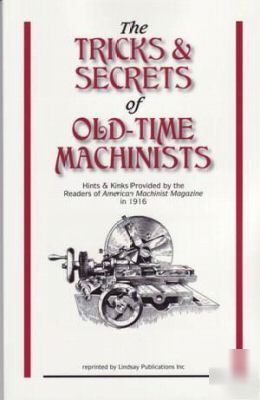|
Hints & Kinks Provided by the Readers of American Machinist Magazine in 1916 In the early days of American Machinist Magazine, readers were constantly asking questions one minute, and offering clever solutions to problems the next. The 1916 issues were particularly rich with the tricks and secrets that experienced old time machinists had devised and had submitted for publication. Machinists were constantly having to machine work that was too big for their equipment. A temporary set up might be necessary. Sometimes an expensive machine part would break and the machinist was called upon to create a simple, low-cost yet durable patch. You'll see how they did it. Some of the articles are of an educational nature: how a large marine crankshaft was fabricated from pieces rather than a single forged billet. Or how to put a simple feeler gauge to valuable use. Or some of the articles were discussions of how to best pull off difficult work such as machining highly accurate angle plates. You'll even find a detailed article on the splicing and use of massive leather belts used to transmit power back then. This is material you can adapt. Many of these articles deal with machines and parts larger than we're likely to encounter. But like my Granddaddy always preached: it's easier to scale something down than to scale it up. The cleverness of the solutions is useful in itself. The imaginative machinist will find ways to adapt these hints and tricks to solve modern problems (and that's supposed to be you). If you're one of those people who just sits on the sidelines and fantasizes about machining metal, here's some great material to feed your fantasies. (But machining metal is like sex: It's great fun to participate but not much fun to watch!) Fun reading. Great ideas - especially for the imaginative machine builder. Interesting historical material when you realize you're getting inside the mind of the experts from a century ago. Straightening a Long Screw * Grinding Threading Tools * A Toolmaker's Novel Clamp * End Mill for Babbitt * Draft Indicator for Patterns * Convenient L-Tool Holder * An Improved Rapping Plate * Machine-Forged Beading Tools * Device To Hold Center Work to Faceplate of Lathe * A Shaper Tool Block * Making Small Rack and Rolls * Old Cutters in Boring Bars * Convenient Adjustable Gage * Spherical Boring on a Lathe * Drilling Long, Small Holes * Setting Angle Plates * Making and Testing a V-Block * Building Large Marine Engine Crankshaft * Round-Bar Tool Holder * Vent Hole in Patterns and Core Boxes * Parallel Expanding Tap * Hobbing Half-Nuts * Toolroom Bench Lathe * Improved Spring Chuck * An Oil Burner with Heating Coil * Machining Large Cast Iron Rings on the Lathe * Threading Ends of Bent Pipes * Expanding Mandrel * Sir Joseph Whitworth on Scraping Practice * Turning a Large Pulley * Repairing the Miller Table * Machining Bronze Fittings in Engine Lathe * Graduating Micrometer Collars * Using the Sine Bar * A Center Drill Chuck * My First Shop Experience * Adjustable Reamer * Grinding a Band-Saw Wheel * Accurate Angle Plates * Hand-Operated Spring Winder * Inspection Square of Special Use With Surface Plate * The Feeler Gage and Its Use * Bench-Lathe Milling * Special Furnace for Melting Babbitt Metal * Melting Aluminum Chips * Care of Leather Belts Reprinted from articles in the 1916 issues of American Machinist Magazine. If you have any questions please e-mail me. (please look at our rules and privacy policy) |
e-schwartz@modularparts.com (Erika Schwartz) for more information. This email will be sent to Erika Schwartz' actual email address.
